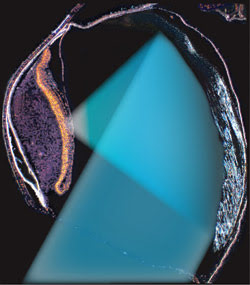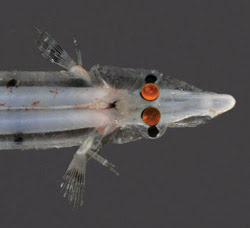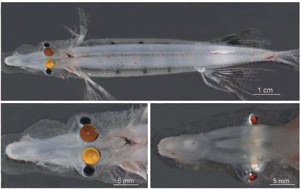When an optical engineer lays out components for a new design, she has more than just a good idea about where the lenses should go and where the mirrors should be. Training and experience have honed her judgment.
In nature, the evolutionary processes that have led to the ability to see for many creatures have leaned heavily toward lenses. Human eyes have them, as do birds, reptiles and mammals of all shapes and sizes. Until recently, it was thought that all vertebrates had eyes that use lenses to direct incoming light to a retina.
Not anymore.
In a recent paper in Current Biology, researchers revealed an amazing fact about the otherwise undistinguished brownsnout spookfish (Dolichopteryx longipes). Unlike every other vertebrate known thus far, D. longipes uses a mirror – not a lens – to direct light to its retinas.

A cross section through the spookfish’s diverticular eye shows the way in which incoming light from a distant object, such as bioluminescent light from a potential meal, is imaged by the mirror onto a point on the diverticular retina. Courtesy of professor Julian Partridge, University of Bristol, UK.
The spookfish was discovered more than 100 years ago, and fishermen and scientists alike have long noted that the creature has tubular eyes that point both toward the surface and toward the seafloor. That eye shape is not unusual; many fish that dwell a kilometer or more below the surface, as does D. longipes, have tubular eyes to maintain awareness of their surroundings. Only the upward-facing end of the tube provides a clear image, however, and until D. longipes was examined more closely, they all were found to use lenses to focus light onto a retina.

The diverticular eyes of the spookfish can be seen reflecting light from underneath in the lower right image. Courtesy of Dr. Tamara Frank, Harbor Branch Oceanographic Institution, Fort Pierce, Fla.
According to the paper’s authors, the mirror is composed of stacks of a crystalline material derived from the eye’s tapetum lucidum, the shiny substance many animals have that makes their eyes reflect the light. The mirror efficiently gathers the dim light available at these depths, giving the spookfish somewhat of an advantage over other fishes, whether predators or potential prey.

The red eyes are tubular on the spookfish, a deep-dwelling fish that is the only known vertebrate that uses a mirror instead of a lens to see. Although the tubular eyes point upward, the black bumps on the side of the head are diverticular eyes that point downward and thus do not reflect light. Courtesy of Dr. Tamara Frank, Harbor Branch Oceanographic Institution, Fort Pierce, Fla.
The scientists who discovered the spookfish’s secret include Julian Partridge of the University of Bristol in the UK and Hans-Joachim Wagner of Tübingen University in Germany.